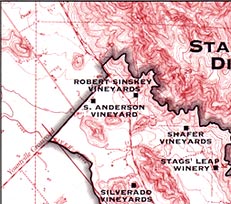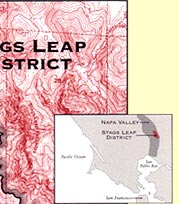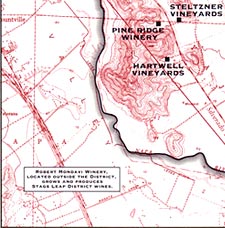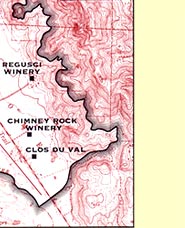
|
|||||
|
|
Left Coast
Correspondent PROFILES: Tasting
Notes from Synergism Up
the Coast More Tasting Notes from the Ridge Galleron Tasting
a Legacy - C O
P I A "T"
is for... Premiere Napa Valley ®
|
||||
|
Terroir. There – I’ve said it. Even though I sometimes prefer not to use the word. It seems that there are as many definitions as there are people discussing the issue. So, with no consensus on meaning, the word becomes meaningless. The notion, however, is undeniable. I think of it in “the total is greater than the sum of its parts” terms. I believe there can be a synergism (gee, that sounds familiar!) between a grape variety, climate and a particular piece of land that gives a wine, or a group of wines, distinctive character. Some time ago my friend Florida Jim Cowan started calling it “a sense of place”, and that made perfect sense to me. It probably is not new, but I prefer to use that phrase now, rather than the “T word”, because there is less room for misunderstanding. This “sense of place” that some wines communicate can express itself in different ways. For some, it is the aromatics. The “garrigue” found in some wines from the Rhône is a good example. (Some argue that the descriptor should only be used by folks who have experienced it themselves, but that’s a topic for another story.) The “cola” aromas in some Russian River Pinot Noir is another. Certainly the “sense of place” can be expressed in a wine’s flavor profile. The earthy, mushroom flavor in Ridge Geyserville is an easy example. Or, it can be both flavor and aroma – as with “Rutherford dust”. This search for the common thread in wines from one area has become fascinating fun for me, so I look forward to certain tastings these days – they give me the opportunity to stretch my tasting awareness, and to look for the less than obvious. And, as I would learn, the “sense of place” that I was looking for is sometimes expressed not through aroma, not through taste, but through texture. Far out. The Concept I guess there are more trade
organizations in the wine industry than you could shake your stem at.
And who could blame them? It’s no secret that the economy is
leaking out the bunghole, and even the more firmly entrenched wineries are
having to work harder to move their product. As a result, more exposure is the
strategy. And, I think it benefits everybody. We
get the opportunity to taste more wines, and pass on to you that which we find
of interest. You get to purchase with the benefit of more information –
whether the opinion you value belongs to us or somebody else - or some
combination. It’s all good. So I welcomed the invitation to the Stags
Leap District Winegrowers Association tasting, where they would
preview their Appellation Collection, a
“Vintner’s Dozen” – one bottle
each of the current and upcoming Cabernet Sauvignon releases from the 13
current Vintner members of the Association. I think it’s an interesting
offer – a case+ of Cabernet Sauvignon from a single appellation. We can
discuss the price issue on another occasion, but for those who have an
interest (as I do) in discovering what specific regions have to offer, this is
a good opportunity – one stop shopping for all your Stags Leap terroir
needs. |
|||||
Map courtesy of the Stags Leap District Winegrowers Association Beginning seven miles north of the
town of Napa, bounded on the north by the Yountville Crossroad,
on the east by the hillsides of the Stags Leap Palisades and the Napa
River to the west, the Stags Leap District encompasses less than three
square miles. The 2700 acres of the District are home to 1300 acres of
vineyards – predominantly Cabernet Sauvignon and other Bordeaux varieties. The District has a rich history that
dates back to the mid 1800s, when the Silverado Trail was just that –
a horse trail. One of the first wineries built was the Occidental
Cellars, constructed in 1878, and now home to Regusci Winery. There were two crucial turning points
in the modern history of Stags Leap. The first was in 1961, when Napa Valley
legend Nathan Fay purchased
property and planted the first Cabernet Sauvignon in the region. Further
plantings followed as other vintners were drawn to the area. In 1976 the relatively unknown region
gained worldwide attention with the infamous Paris tasting held by Steven
Spurrier, and in 1989, the Stags Leap District received AVA designation
from the Bureau of Alcohol, Tobacco and Firearms (BATTY). The rest is thistory. The Wines | The Lunch | Winemaker Interviews | Conclusions © Allan Bree July 2003
|
|||||





